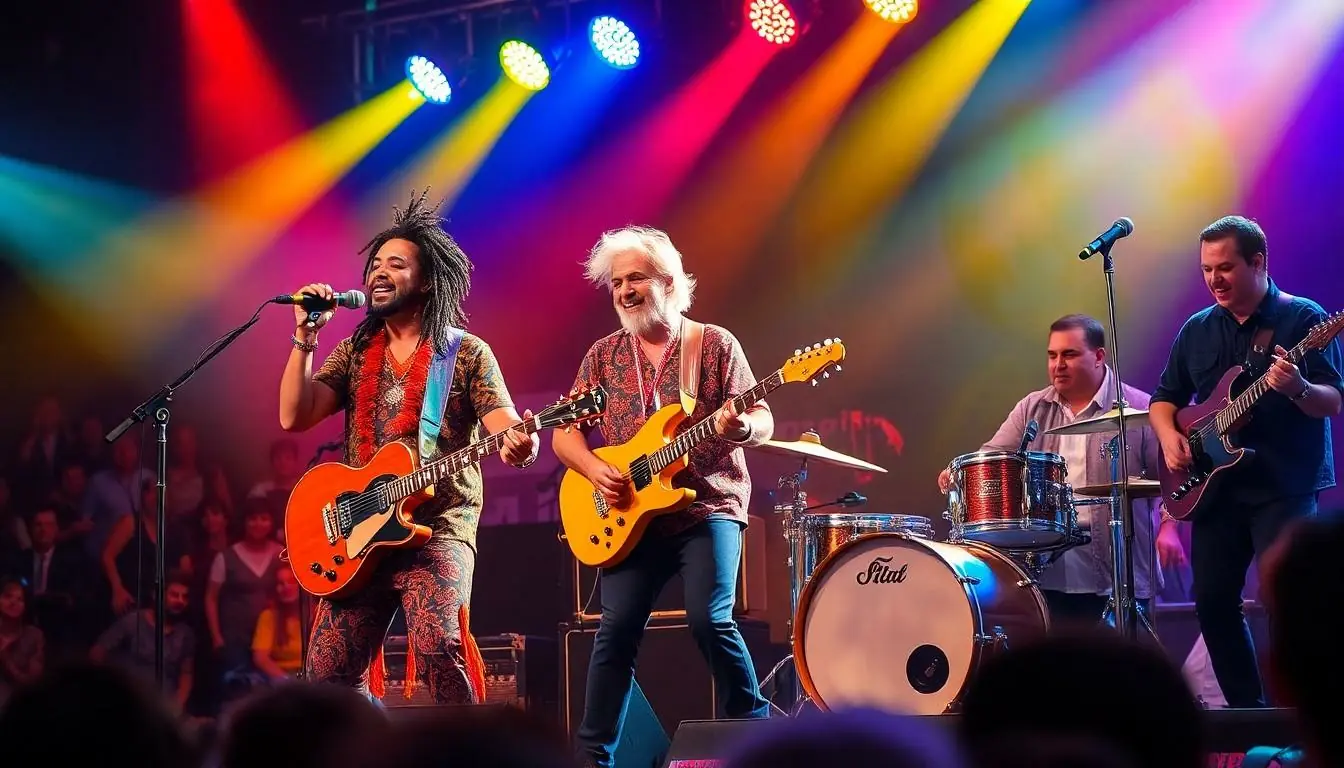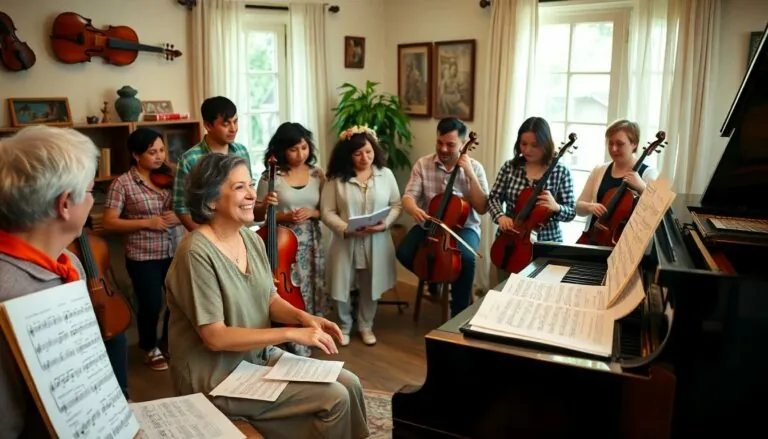Table of Contents
TogglePop music isn’t just a genre; it’s a cultural phenomenon that makes the world go round—sometimes literally, if you’ve ever found yourself dancing in your living room. From catchy hooks to infectious beats, pop music has a way of worming its way into hearts and minds, turning even the most serious of folks into spontaneous karaoke stars.
With its vibrant energy and relatable themes, pop captures the essence of modern life. Whether it’s the latest chart-topping hit or a nostalgic classic, pop music connects people across generations and backgrounds. So, grab your headphones and get ready to dive into the colorful universe of pop, where every song tells a story, and every beat invites you to join the party.
Overview of Music Pop
Pop music represents a broad category encompassing various styles and trends. This genre often integrates elements from rock, hip-hop, electronic, and R&B, creating a diverse soundscape. Catchy melodies and memorable hooks define pop tracks, making them appealing to a wide audience.
The lyrics in pop songs frequently revolve around relatable themes such as love, friendship, and empowerment. Artists like Taylor Swift and Bruno Mars exemplify the personal storytelling indicative of contemporary pop. Evolution within the genre showcases artists adapting to societal changes and technological advances, which keeps pop music relevant.
According to the Nielsen Music data, pop music consistently dominates the charts, highlighting its popularity across demographics. In 2020, pop accounted for approximately 25% of total music consumption in the U.S. These statistics illustrate pop’s significant cultural impact and ability to resonate with listeners.
Collaborations between pop artists and musicians from other genres continue to push boundaries and foster innovation. This blending of styles often results in chart-topping hits that capture wide-ranging audiences. Recent examples include the collaborations of Dua Lipa with Elton John and The Weeknd with Ariana Grande, showcasing the fluidity within the genre.
As pop music evolves, it maintains its core essence: accessibility and enjoyment. Each release invites listeners to engage and participate, reinforcing the genre’s role as a unifying force in the music landscape. The next wave of pop will likely continue to surprise, reflect cultural shifts, and inspire joy worldwide.
Origins of Music Pop

Pop music’s roots trace back to the early 20th century, emerging from various musical traditions. Early influences shaped pop’s catchy melodies and relatable themes.
Early Influences
Jazz and blues laid a foundation for the sound of pop music, directly influencing its rhythm and emotion. The 1950s introduced rock and roll as a vital component, showcasing artists like Elvis Presley and Chuck Berry who captured mainstream attention. R&B also played a significant role, with artists like Ray Charles and Aretha Franklin blending soulful melodies into pop. These genres contributed key elements that defined pop music’s catchy hooks and accessible style, setting the stage for future evolution.
Evolution Through Decades
During the 1960s, pop began to embrace experimentation, with bands like The Beatles incorporating diverse influences. The 1970s and 1980s brought disco and synth-pop, featuring artists such as Madonna and Michael Jackson who dominated the charts. Advancements in technology allowed for new production techniques. The 1990s introduced boy bands and girl groups, enhancing pop’s appeal to youth culture with acts like Backstreet Boys and Spice Girls. This evolution illustrates how pop music adapts to changing tastes while maintaining its core theme of universal relatability.
Key Characteristics of Music Pop
Pop music features distinct characteristics that define its appeal. Catchy melodies and hooks create an engaging listening experience, capturing listeners’ attention instantly.
Melodic Structure
Melodic structure plays a critical role in pop music’s success. Most pop songs follow simple chord progressions, making them easy to remember and sing along. Typically, melodies are upbeat and repetitive, enhancing their catchiness. Musical phrases often adhere to a verse-chorus format, providing contrast and dynamics. These structures establish familiarity, inviting listeners to join in. This approach promotes accessibility, reinforcing pop music’s widespread popularity.
Themes and Lyrics
Themes and lyrics shape the emotional core of pop music. Common subjects include love, heartbreak, and self-empowerment, reflecting universal experiences. Lyrics often convey relatable narratives, allowing audiences to connect with the artists’ personal stories. Furthermore, many pop songs employ anthemic choruses that inspire participation and evoke feelings of joy. Artists like Taylor Swift and Bruno Mars excel at crafting lyrics that resonate across age groups. Such relatable themes highlight pop music’s significance in building emotional connections within diverse listeners.
Notable Artists in Music Pop
Pop music features an array of influential artists shaping the genre across generations. Their contributions define both its past and present.
Past Legends
Icons like Elvis Presley and Aretha Franklin set the foundation for modern pop. Elvis, known as the King of Rock and Roll, infused pop with his energetic performances. Aretha, hailed as the Queen of Soul, brought depth through her powerful vocals. Additionally, Michael Jackson revolutionized the industry with innovative music videos and unforgettable hits like “Thriller.” These legends laid the groundwork, influencing countless artists that followed. Their signature styles and captivating artistry marked pivotal moments in pop history.
Contemporary Icons
Artists such as Taylor Swift and Bruno Mars dominate today’s pop music scene. Taylor’s storytelling ability resonates with a wide audience, capturing personal experiences in relatable ways. Bruno combines various genres, creating catchy tunes that engage listeners. Billie Eilish stands out with her unique sound and genre-blending approach, bringing a fresh perspective to pop. Dua Lipa’s anthems emphasize empowerment, connecting with younger generations. These contemporary icons continue to evolve the genre, pushing boundaries and expanding its reach while inspiring new talent.
The Impact of Music Pop on Culture
Pop music influences various aspects of culture beyond sound, shaping trends in fashion and social movements.
Influence on Fashion
Pop music shapes fashion trends, creating iconic styles that resonate with listeners. Artists like Madonna and Lady Gaga have defined eras, influencing not just music but also fashion choices. From vibrant outfits to cutting-edge accessories, pop stars inspire fans to embrace different aesthetics. The “streetwear” trend owes much to influences from pop culture, merging comfort and style in everyday wear. Runway shows often feature designs inspired by pop music phenomena, showcasing how deeply intertwined these fields become. In 2020, a study indicated that 60% of fans cite pop artists as their style icons, highlighting this powerful connection.
Role in Social Movements
Pop music serves as a powerful catalyst for social change, providing a voice for various movements. Songs like “Born This Way” by Lady Gaga and “Fight Song” by Rachel Platten inspire empowerment and equality. These anthems resonate, motivating listeners to advocate for social justice and human rights. Artists often use their platforms to raise awareness, with many participating in charity events and campaigns. Research shows that artists’ involvement in activism can significantly increase public engagement, indicating the profound impact of their influence. The combination of catchy tunes and meaningful messages creates lasting impressions, encouraging audiences to take action and engage with societal issues.
Pop music remains a dynamic force that resonates with audiences everywhere. Its ability to blend diverse influences while maintaining catchy melodies ensures its enduring appeal. As artists continue to innovate and adapt, pop music will likely evolve in ways that reflect societal changes and cultural trends.
This genre’s power lies not just in its sound but in its capacity to unite people through shared experiences. Whether through anthems of empowerment or relatable love songs, pop music invites listeners to connect on a personal level. As we look ahead, the future of pop promises to deliver fresh sounds and inspiring messages that will captivate generations to come.






